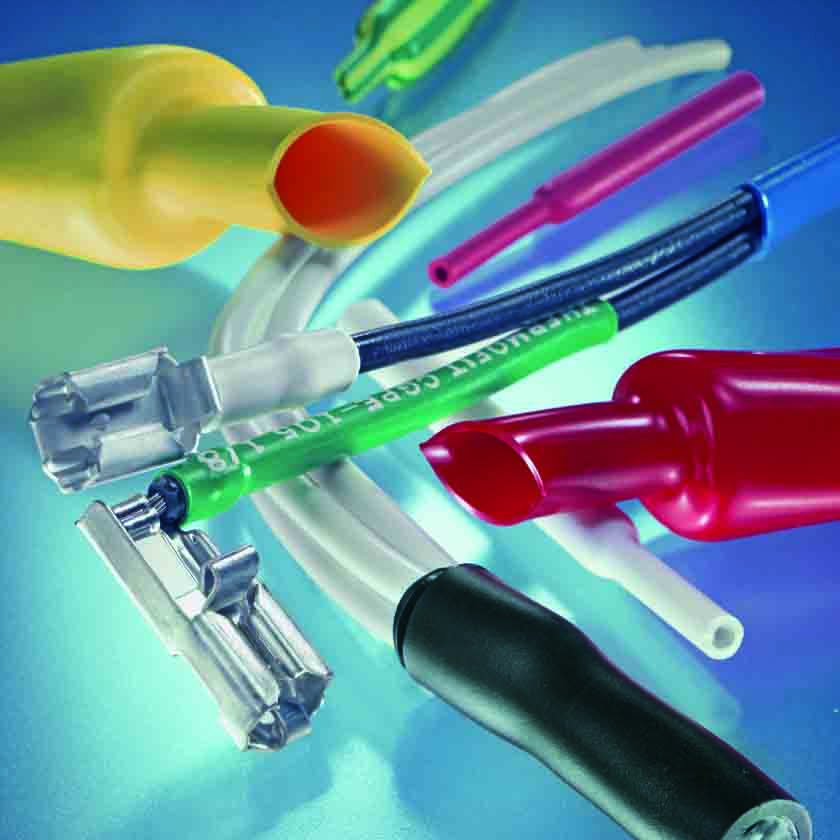Heat-Shrink Products and Their Application Demands
By: TE Connectivity
Heat-shrink tubing has been a staple in the electronics industry for more than 50 years. It is used for sealing, protecting, insulating, strain-relieving, and identifying wires and cables.
By cross linking polymers, you achieve a material that allows you to do things you cannot do with uncross-linked materials. For heat-shrink tubing, a tube of plastic, such as commonly used polyolefin, can be heated and expanded to several times its diameter. When cooled, it will remain in its expanded state. When the tubing is heated again, it will contract back to its original size. Because the tubing is shrunk over a substrate somewhat larger than its original size, the tubing fits tightly and securely against the substrate.
Heat-shrink tubing has many uses in electronics. Four of the main uses are:
- To insulate an electrical component
- To seal against moisture and other contaminants
- To provide strain relief, especially at terminations
- To protect against abrasion and other mechanical abuse
Heat-shrink tubing can be made of many different materials to meet different application needs. Polyolefin is widely used for most applications. Polyolefin-based tubing is available in a wide range of formulations to extend its application over a broader spectrum of application needs. Other materials allow better abrasion resistance, a wider temperature range, or protection against aggressive chemicals and solvents.
The thickness of the tubing wall can be changed to provide better flexibility or increased stiffness. Thin walls tend to be more flexible, while thicker walls provide more rigidity and abrasion protection.
Dual-wall heat-shrink tubing offers an inner layer of heat-sensitive adhesive. When the tubing is shrunk back to its original size, the adhesive bonds the tubing to the substrate.
Figure 1 – Heat-shrink tubing is available in a variety of colors and materials to meet many application ranges. (Source: TE Connectivity)
Trend toward Special-Purpose Tubing
As noted, polyolefin is the workhorse material for heat-shrink tubing. Much of the recent innovation in heat-shrink products involves either modifying polyolefin formulations to meet special requirements or using other materials to expand the range of possible applications. Tubing used in space applications, for example, must exhibit low outgassing properties. This need for very “clean” materials makes the formulation very important. Specific application needs drive tubing development. A few examples:
NBCCS: In military applications, nuclear, biological, and chemical contamination survivability (NBCCS) requires materials that do not absorb contaminating agents and can withstand the harsh materials of washdown and cleanup.
Medical: For medical needs, materials meeting U.S. Pharmacopeia Class VI standards allow tubing to withstand repeated sterilization by autoclave, gamma radiation, ethylene oxide, steam, and dry heat. Polyether block amide copolymer (PEBA) eliminates the requirement for expensive processing aids such as an overtube or fusion sleeve. In addition, the PEBA can be modified to achieve different degrees of flexibility or rigidity.
High temperatures: Heat-shrink tubing must provide performance equal to the harness on which it is used. As the heat environment of many applications increases, so does the need for harnessing components to withstand elevated temperatures.
Since heat tends to degrade plastics, special attention is needed for tubing that will be used in high-temperature environments. Polyolefin, for example, has an upper service temperature of around 125°C (although this can be adjusted with additives). PTFE and FEP fluoropolymer tubing can handle +200°C, but are more expensive.
The temperature rating for heat-shrink tubing can typically refer either to the shrink temperature that must be applied to achieve optimum shrinkage of the material or to the operating temperature range. Both are important to consider in selecting heat-shrink tubing, as is the temperature rating of the components it is used on.
LSZH: Low-smoke, zero-halogen (LSZH) tubing does not emit toxic fumes or generate smoke when exposed to fire, making it the ideal complement to LSZH wire and cable used in the mass transit industry.
Molded Shapes
The ability to mold heat-shrink materials into shapes adds a new dimension of convenience to harnessing. Molded shapes can be used for transitions and cable breakouts, for strain relief on cable backshells, and for similar needs. The key is that the molded shape does, indeed, have a specific geometry matched to its application. Molded shapes are available in off-the-shelf configurations matched to common applications or in custom shapes.
Traditionally molded shapes have tended to be thick-wall materials with more rigidity to relieve strain and protect terminations or branches in electrical systems. As the market drives toward smaller, lighter circuits, we find molded shapes following this trend also. Micro-boots are now a popular commodity.
Figure 2 – Molded parts give greater application flexibility in breakouts and in covering oddly shaped parts. (Source: TE Connectivity)
Tapes and Wraps
Wiring harnesses and cable assemblies may need repaired or modified to extend their useful service life. Insulation becomes abraded or cut. Connectors need contacts replaced. Quick field repairs may be needed while awaiting permanent replacement parts. Tapes and wraps overcome the impracticality of using heat-shrink tubing in such situations by allowing side entry. Adhesive-lined tapes provide sealing and robust insulation.
It’s a Family Affair
As the environmental and mechanical demands on harnesses increase, every component must be carefully evaluated for suitability. To simplify selection of heat-shrink components, look for suppliers taking a system-level approach by offering tubing, tapes, and molded shapes as a matched family suited to the application environment.
Figure 3 – Molded heat-shrink parts have shrunk. Micro-sized parts save space and weight. (Source: TE Connectivity
Supporting Sustainable Designs
Application demands are one thing. The environment and the drive for sustainable designs are another. Environmental concerns are driving toward safe and recyclable materials. Environmentally friendly wire and cables require materials free of halogens, heavy metals, and other materials to allow easy recycling; as products come on the market, there is also a demand for companion heat-shrink products. While application requirements and environmental friendliness are often seen as polar opposites, the challenge is to make them co-exist. Heat-shrinkable products are among those on technology’s forefront offering challenging solutions to industry and the environment.
Conclusion
At the low end, heat-shrink tubing is thought of as a commoditized product. It is available from a range of suppliers to meet general-purpose needs of sealing, insulation, and protection. But not all tubing is a generic commodity— differences exist in the material expertise used to formulate specialty polymers and for production process controls that lead to exceptional uniformity in shrink properties, low longitudinal shrinkage, and long-term aging stability. For demanding applications, few suppliers have the expertise to use new materials and adjust formulations to achieve such requirements as low outgassing, resistance to the widest range of fuels and chemicals, and performance at extreme temperatures.
te.com
TE, TE Connectivity, TE connectivity (logo) and Tyco Electronics are trademarks of the TE Connectivity Ltd. family of companies and its licensors.
While TE Connectivity has made every reasonable effort to ensure the accuracy of the information in this document, TE Connectivity does not guarantee that it is error-free, nor does TE Connectivity make any other representation, warranty or guarantee that the information is accurate, correct, reliable or current. TE Connectivity reserves the right to make any adjustments to the information contained herein at any time without notice. TE Connectivity expressly disclaims all implied warranties regarding the information contained herein, including, but not limited to, any implied warranties of merchantability or fitness for a particular purpose. The dimensions in this document are for reference purposes only and are subject to change without notice. Specifications are subject to change without notice. Consult TE Connectivity for the latest dimensions and design specifications.
© 2015 TE Connectivity Ltd. family of companies. All Rights Reserved.

































































